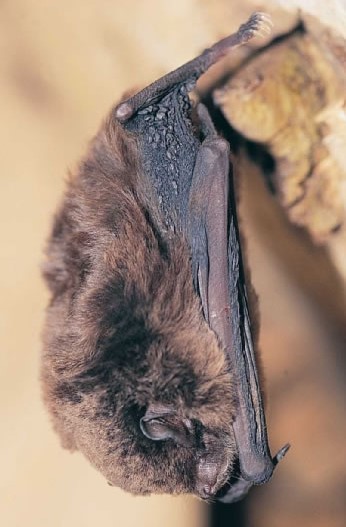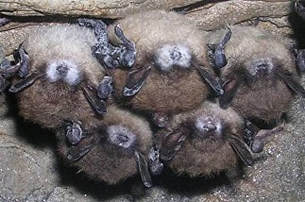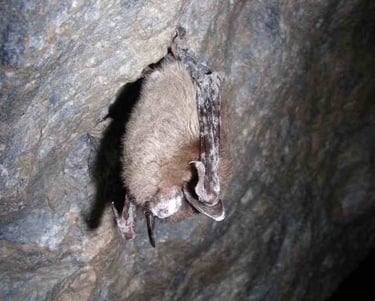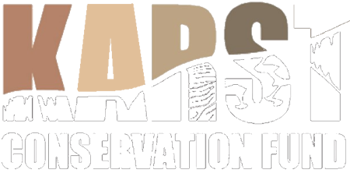White Nose syndrome in cave dwelling bats
Cave dwelling bats in South Eastern Australia are considered at risk of WNS should, or rather when, the fungus enters Australia. An overview about the risks of WNS to Australian bats is available on the Australian Bat Society website.
About the project
Starting point
ASF support is as a partner in a Linkage Project with Western Sydney University and University of Melbourne. Dr Chris Turbill is heading the project. ASF support is financial and assistance with cave information, maps and access support.
The project will continue for next three years, ending 2026.
Support from Western Sydney & Melbourne Uni's
Over the past 20 years WNS has caused millions of bats to die in North America and is spread via the clothing and shoes of people who have visited caves in the US and Europe.
This project studies the over-wintering and hibernation biology of the critically endangered Eastern Bent-wing Bat in South Eastern Australia to estimate the vulnerability of cave dwelling bats to the White Nose Syndrome (WNS) fungus (Pseudogymnoascus destructans).
About the Researchers
Lead Researchers
Dr Chris Turbill, Western Sydney University and
Dr Jasmine Hufschmid at University of Melbourne.


Eastern Bent-wing Bat


North American Little Brown Bats with WNS on faces and wings
THE STORY
Preventing White Nose Syndrome entering Australia
The White Nose Syndrome was detected in bats in and around hibernation caves in North East USA and there is an associated very high mortality rate. It is associated with fat depletion and bats in poor condition may have a fungal infection around the nose, hence the name.
A number of species of cave dwelling bats are affected including three species of Myotis and one of Perimyotis. The syndrome was recognised in the winter of 2006-7 in two caves in New York State. During the present 2007-8 winter affected bats have been found in at least 20 caves and mine sites in New York State, Vermont, Massachusetts and West Virginia showing the syndrome has spread geographically from the original sites.
The mortality estimate for the two original caves was 90 and 97% and it has galvanised the State and Federal instrumentalities to investigate and research the problem.
Spreading Agents
It is currently quite unclear whether the spread is due to an infectious agent or some other environmental factor such as climate, food availability or environmental contaminants. The bats use other caves and mines during spring, summer and autumn and multiple species share the same caves. It is also not certain whether the apparent spread of the syndrome is from bat to bat transmission or whether spread has been caused by humans transferring “infectious agents” from cave to cave.
Decontamination guidelines
Use hypochlorite based bleach solutions (bleach diluted 1/10). The protocol is appropriate for all clothing and boots. Should vertical gear (ropes and webbing) need decontamination you should consult the NSS cave chat forum..


For cavers this reinforces the need to clean your clothing, boots and equipment between different caves, different cave areas and particularly when returning from anywhere overseas. This is provided for in our current Minimum Impact Caving Code.
A cleaning protocol to minimise the risk of introducing fungi or other infectious agents that might be specifically associated with the white nose syndrome, based on decontamination with bleach, is provided below in the current US Fish and Wildlife advice for white nose syndrome. This protocol is suitable for decontamination between caves and cave areas where infectious agents are a concern (histoplasmosis) or for blood contamination.
Ideally, it would be best if any clothing or other gear worn in a cave in North America is not brought back into Australia.
Should there be a causative infectious agent of white nose syndrome our cave dwelling bats must be considered susceptible and this is why there is very real Australian concern about this syndrome.
USA and White Nose
Australian Context
Caves Australia acknowledges Aboriginal and Torres Strait Islander peoples as the traditional owners and custodians of the land, rivers, and sea on which we live, and we pay our respects to their Elders past, present and emerging. We acknowledge and respect the deep spiritual connection that Aboriginal and Torres Strait Islander people have to Country, especially to caves.
This site is sponsored by the Conservation Commission of Caves Australia.






